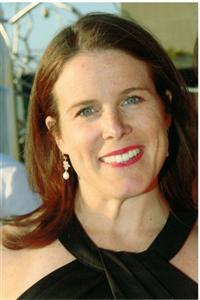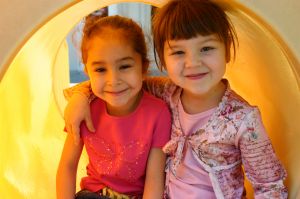What I Didn’t Expect When I Was Expecting
By Guest Blogger Susan Hannan
They say that nothing can prepare you for being a mother. I don’t know who “they” are, but in my case, “they” could not be more right. Upon learning we were about to start a family of our own, my husband and I were beyond ecstatic. So, when I started having back pain at 26 weeks, it never occurred to either of us that something was about to go wrong. Even when the nurses at Duke asked my husband if he would like a tour of the Neonatal Intensive Care Unit (NICU), he politely declined.
But, at 27 weeks, my daughter, Kaitlyn arrived. Weighing in at only 2 pounds and 12 ounces, our daughter led us on a roller coaster of emotions. The doctors and nurses in the NICU repeatedly told us that “every day in the NICU is a new day. Today may be a good day, but tomorrow may be a bad day.” It was heart-wrenching to leave Kaitlyn in the NICU, and yet, there was no way that I could care for her at home. Nurses literally stood by my daughter 24 hours a day and tickled her toes when she forgot to breath. The incubator regulated her temperature. I could go on and on, but in the end, I will remember that the NICU provided Kaitlyn what my body failed to give her.
Three years later, we found out we were expecting again and our hearts were filled with joy, but we were also scared. I remember being in the obstetrician’s office and crying about the guilt I felt from not carrying Kaitlyn to term. From about 24 weeks along, I waited for another premature birth. But, as my children still demonstrate today, they are complete opposites. Jordan, my second daughter, was born one week after her due date – in fact, my labor had to be induced. Naively, I thought that a full-term baby meant a healthy child.
 At age 2 ½, Jordan was diagnosed with Marfan Syndrome. It started with a simple trip to the eye doctor, but when the ophthalmologist politely, but firmly told me that my daughter needed to see a cardiologist, it rocked me to my core. Marfan Syndrome is a genetic condition that affects the connective tissue in a person’s body. People with Marfan Syndrome tend to be very tall, with long fingers and toes. They often have poor eyesight and may develop scoliosis. Marfan Syndrome also affects the heart and causes a person’s aorta to grow disproportionate to the rest of their heart. If not detected or properly monitored, this can result in aortic dissection.
At age 2 ½, Jordan was diagnosed with Marfan Syndrome. It started with a simple trip to the eye doctor, but when the ophthalmologist politely, but firmly told me that my daughter needed to see a cardiologist, it rocked me to my core. Marfan Syndrome is a genetic condition that affects the connective tissue in a person’s body. People with Marfan Syndrome tend to be very tall, with long fingers and toes. They often have poor eyesight and may develop scoliosis. Marfan Syndrome also affects the heart and causes a person’s aorta to grow disproportionate to the rest of their heart. If not detected or properly monitored, this can result in aortic dissection.
Jordan is carefully monitored by a geneticist, cardiologist, ophthalmologist and orthopedic doctor. She takes daily medications and receives an annual echocardiogram. Jordan is not allowed to play in competitive or contact sports for fear of the strain it could put on their heart. Each school year starts with a meeting with the teacher so they understand her limitations. A PE teacher must know that under no circumstances should Jordan be the goalie in soccer. A trip to an amusement park is fraught with questions for the ride attendants – how bumpy is this ride? Are there sudden stops and starts? As a mom, the fear is there at all times. Last year, the school nurse called to tell me that Jordan was having chest pains. I work five minutes from the school, but that ride felt like an eternity. It was so long, I had to call the school as I was driving to know what was happening. Thankfully, an emergency echocardiogram from Duke told us that her heart was fine.
 I’ll never forget the day Jordan looked up at me with her big, blue eyes and asked, “Am I one of the sick kids, Mommy?” The doctors tell us that Jordan should be allowed to have a normal childhood. “Don’t treat her differently,” they say, but how can you not? You can’t ignore the small aches and pains of a child with Marfan Syndrome because what if they are a precursor to something much worse?
I’ll never forget the day Jordan looked up at me with her big, blue eyes and asked, “Am I one of the sick kids, Mommy?” The doctors tell us that Jordan should be allowed to have a normal childhood. “Don’t treat her differently,” they say, but how can you not? You can’t ignore the small aches and pains of a child with Marfan Syndrome because what if they are a precursor to something much worse?
Plan all you want, but parenthood has a way of throwing curveballs at you and hopefully, you have a strong support network to fall back on and a sense of humor. I will forever be indebted to those that saved my child when she were born too early and those that fund research to find better treatments. There are no words that are strong enough to express our gratitude. All we can do is give back; therefore, we founded the Kaitlyn & Jordan Classic golf outing as our way of saying thank you.
This year’s event will be held on Monday, October 13, 2014 at the Preserve at Jordan Lake in Chapel Hill, NC. All proceeds from this charity event are given to the Duke Neonatal Intensive Care Unit and The Marfan Foundation. For more information, please visit www.KaitlynClassic.com or email me at susan.hannan16@gmail.com.
Unlike parenthood, I can plan this event out in all its details! Except for last year, when it poured rain! But in the end, it all worked out. It always does. Just look at these two…
Photo Captions: Top image is Kaitlyn’s first Halloween; second image is of Jordan with her first pair of glasses; third image is of Kaitlyn and Jordan in 2014).




























